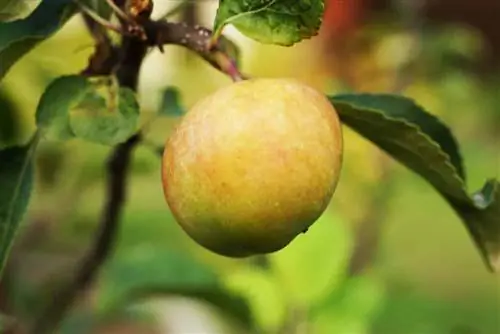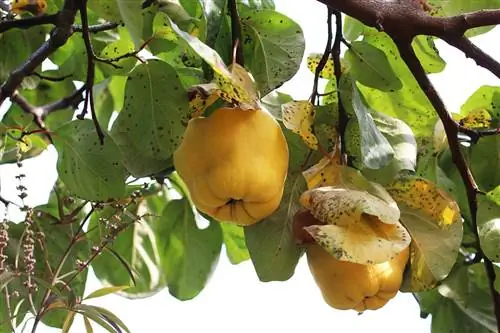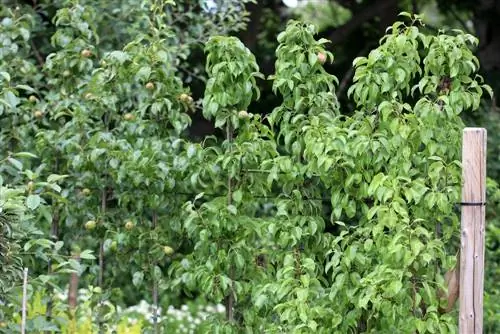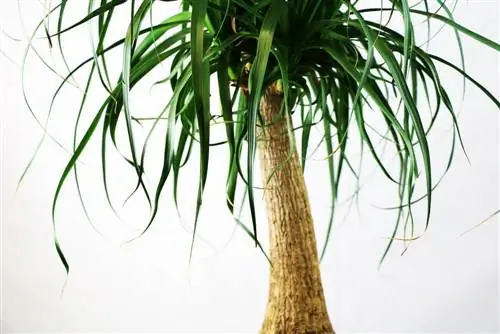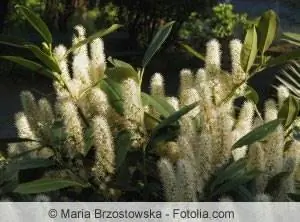- Author admin [email protected].
- Public 2023-12-17 03:39.
- Last modified 2025-06-01 06:48.
Apple, pear, mirabelle plum - fruit trees are much more than just an ornament in the garden and are very popular with many. The free space around the tree trunk is called a tree disk. However, this often looks bare because not everyone dares to plant fruit trees underneath. In fact, there are a few things that need to be taken into account, because both the underplanting and the fruit trees can suffer if the wrong plants are chosen.
Shallow and deep roots
An important factor when choosing the right underplanting for fruit trees is the growth habit of their roots. If they are shallow-rooted, particular care must be taken when planting the root disk. Otherwise, the root network lying low underground could be damaged. There is also the risk that the plants will have to compete for water and nutrients and will suffer as a result.
It is therefore worth paying attention to when planting fruit trees under the tree, whether it is a shallow, deep or heart-rooted tree. The shallow-rooted plants include apples and pears as well as berry bushes. Corresponding information about the root shape of more unusual types of fruit can be obtained from specialist retailers.
Sun and Shadow
The larger the crown of the fruit tree, the more shade it provides - this sounds logical and obvious, but is not always taken into account when planting under it. This is very important so that the plants can thrive. For fruit trees in pots or on hills, plants that require a sunny or partially shaded location are recommended. For the tree disc of large, densely grown trees, however, it should be plants for semi-shady to shady locations.
Types of fruit trees
In addition to the type of root growth and the lighting conditions at the location, other factors also play a role in determining whether the underplanting suits the respective fruit tree. These include:
- Substrate
- Water requirements
- Nutrient requirements
- Possible interactions between fruit trees and underplanting
Pay particular attention to the last point. For example, if the underplanting releases essential oils or other substances, this can result in a lack of flowers and a harvest on the fruit tree. It may also be possible that insects necessary for pollination are deterred. In addition, the underplanting can absorb nutrients that the fruit tree then lacks. With the right plants, however, a positive interaction can be achieved. For example, some plant species are suitable for attracting bees to pollinate flowers and thus potentially increase the harvest.
Apple tree
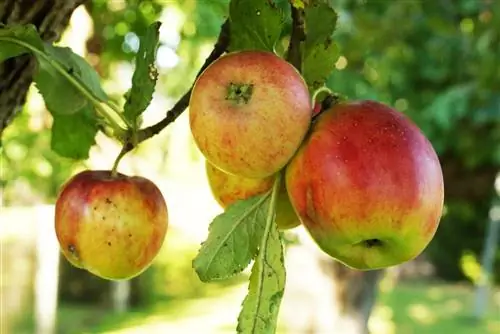
Especially with apple trees, underplanting not only makes better use of the space in the garden, but the tree can also be protected from diseases. Suitable plants for this include:
- Columbine: Attracts insects and can thus improve pollination
- Berry bushes: Their smell keeps pests such as rodents away
- Monkshood: suitable but poisonous
- Nasturtium: Form living mulch, keeps apple leaf suckers away
- Garlic: Reduces the risk of scab
- Dandelions: Reduces the risk of leaf chlorosis
- Rhubarb: Forms living mulch
- Marigold: Suitable and also useful as a medicinal plant, attracts insects
- Chives: Reduces the risk of scab
- Violet: Attracts insects
Apricot
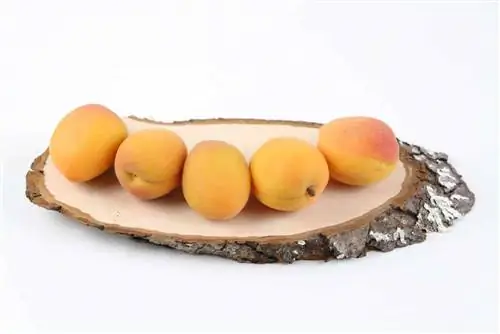
The following are suitable under apricot trees:
- Stinging nettle: To strengthen the tree and ward off aphids and ants
- Nasturtium: Effective against blood lice
- Melissa: Strengthens the he alth of the apricot tree
- Peppermint: Strengthens the he alth of the apricot tree
- Marigold: Effective against blood lice
- Tomatoes: Keeps aphids, ants and other pests away
Pear
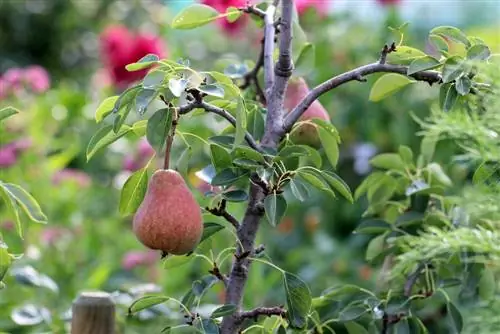
The following plants not only feel comfortable under the pear tree, they also have positive effects on the he alth of the plant:
- Fimglove: Effective against rubber flow
- Geraniums: Attracts insects and can thereby improve pollination
- Nasturtium: Deters aphids
- Dandelions: Reduces the risk of leaf chlorosis
- Deadnettle: As a living mulch and to protect the roots
Cherry tree
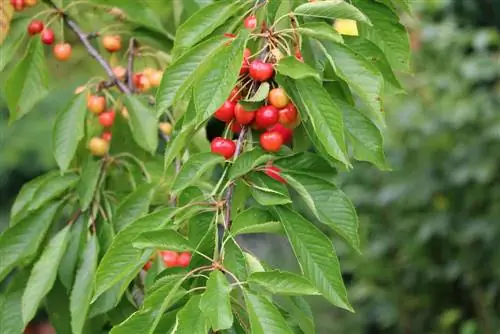
The following plants are welcome to grow under the cherry tree if you want to achieve a positive effect with the underplanting:
- Nasturtium: To ward off aphids
- Garlic: To ward off aphids
- Lily of the valley: Effective against Monilia
- Melissa: Strengthens the tree
- Peppermint: Strengthens the tree
- Red Foxglove: Can prevent rubber flow
- Chives: To ward off aphids
Mirabelle
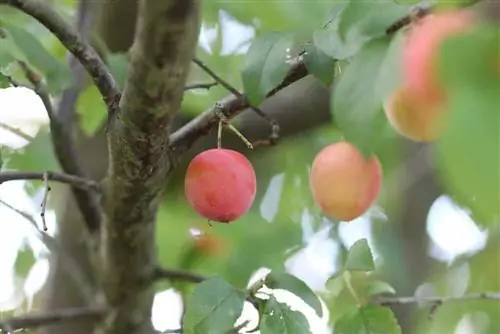
So that the delicious fruits can be harvested in as many quantities as possible and the mirabelle plum tree remains he althy, the following plants are recommended for underplanting:
- Onion: Keep pests away, among other things
- Garlic: To ward off aphids
- Geranium: Attracts beneficial insects for pollination
- Clover: Forms living mulch
- Mustard: Repels pests
Peach
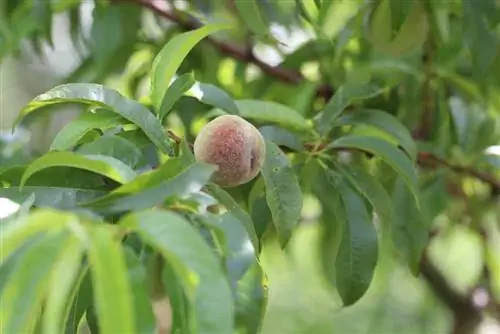
They should be sweet and juicy and are best harvested fresh from the tree. If you want to do something good for the peach tree, choose one or more of the listed suitable plants for the underplanting:
- Garlic: Attracts beneficial insects and keeps pests away
- Nasturtium: Helps against bacterial gangrene and curl disease
- Tomatoes: Effective against aphids, ants and other pests
- Horseradish: Against pests and curl disease
Plum and plum
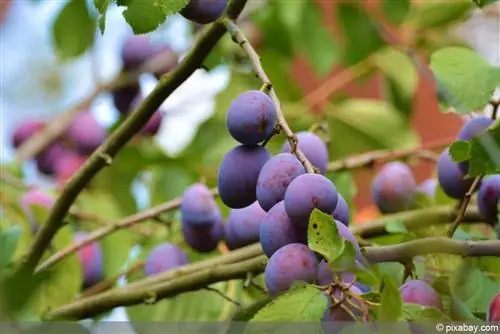
Plums and damsons sweeten our summer. However, the stone fruits can also be attacked by diseases and pests. The right underplanting helps the fruit tree to grow strong and he althy and to produce the highest possible yield:
- Lamb lettuce: Covers the soil and thereby retains moisture, attracts earthworms
- Garlic: Keeps pests away and attracts beneficial insects
- Lark Spur: Attracts beneficial insects, but is poisonous
- Report: Suitable as a vegetable and protects the soil, forms living mulch
- Phacelia: Attract bees and serve as green manure
- Scarywort: Serves as soil protection and to attract bees, forms live mulch
Free or bucket?
For underplanting and the benefits from it, it is not absolutely necessary that the plants are actually planted on the tree disc. The plants can also be grown in pots and placed on it. This method even offers some advantages:
- Combination possible with plants that have different substrate and care requirements
- Planting of plants that are not winter or frost hardy is possible
- The risk of damage to the roots is eliminated
- The plants can be quickly replaced
A possible disadvantage, however, is that the plants no longer serve as green manure and - for example in the case of lamb's lettuce - do not have a positive influence on the quality of the soil. It is therefore important to weigh up which factors play the greater role in each case.
Underplanting or planting neighbor?
All of the plants mentioned do not have to sit directly on the tree disc in order to develop their positive effects. They can also have a beneficial influence on the fruit trees if they are simply their plant neighbors - i.e. planted close to the area.

